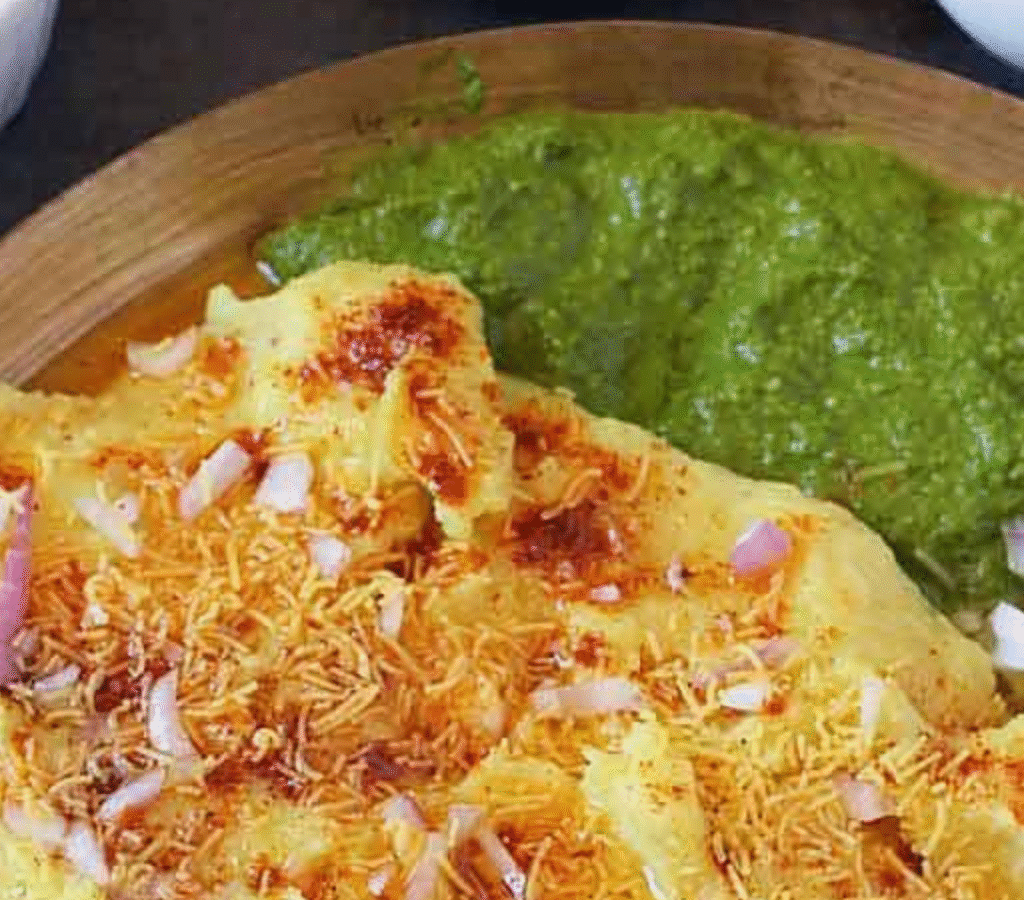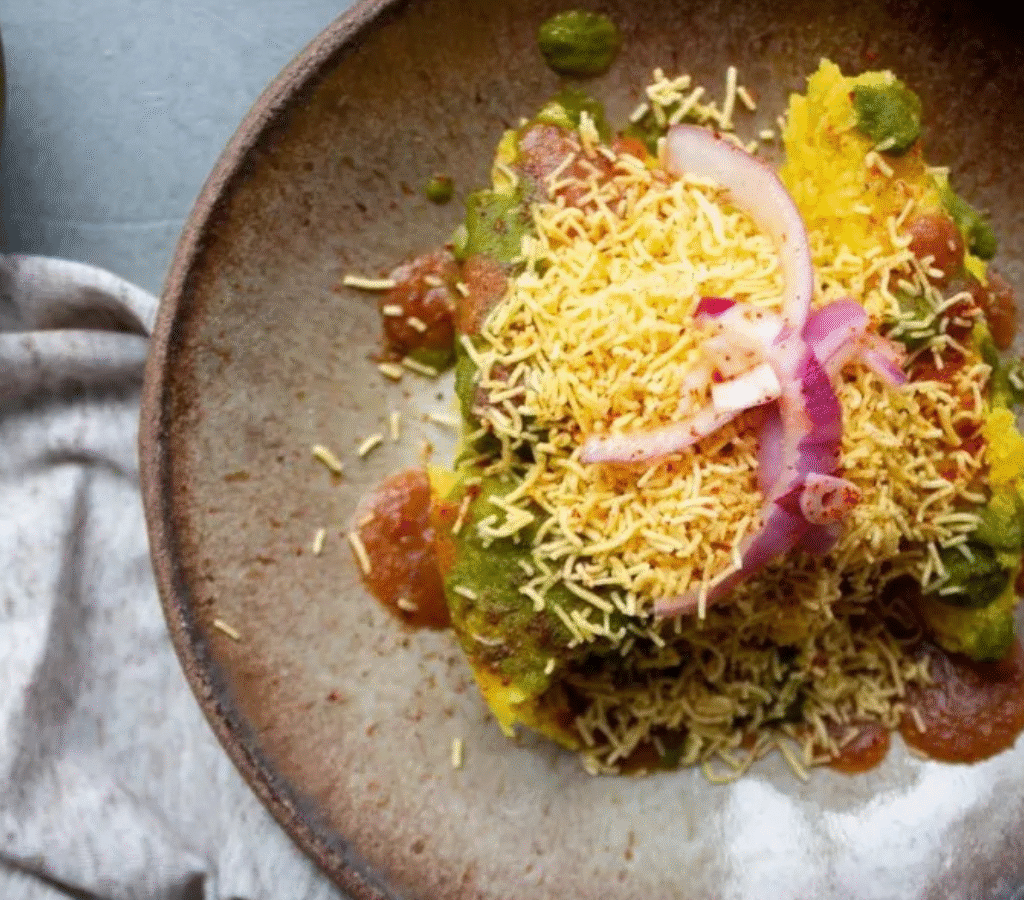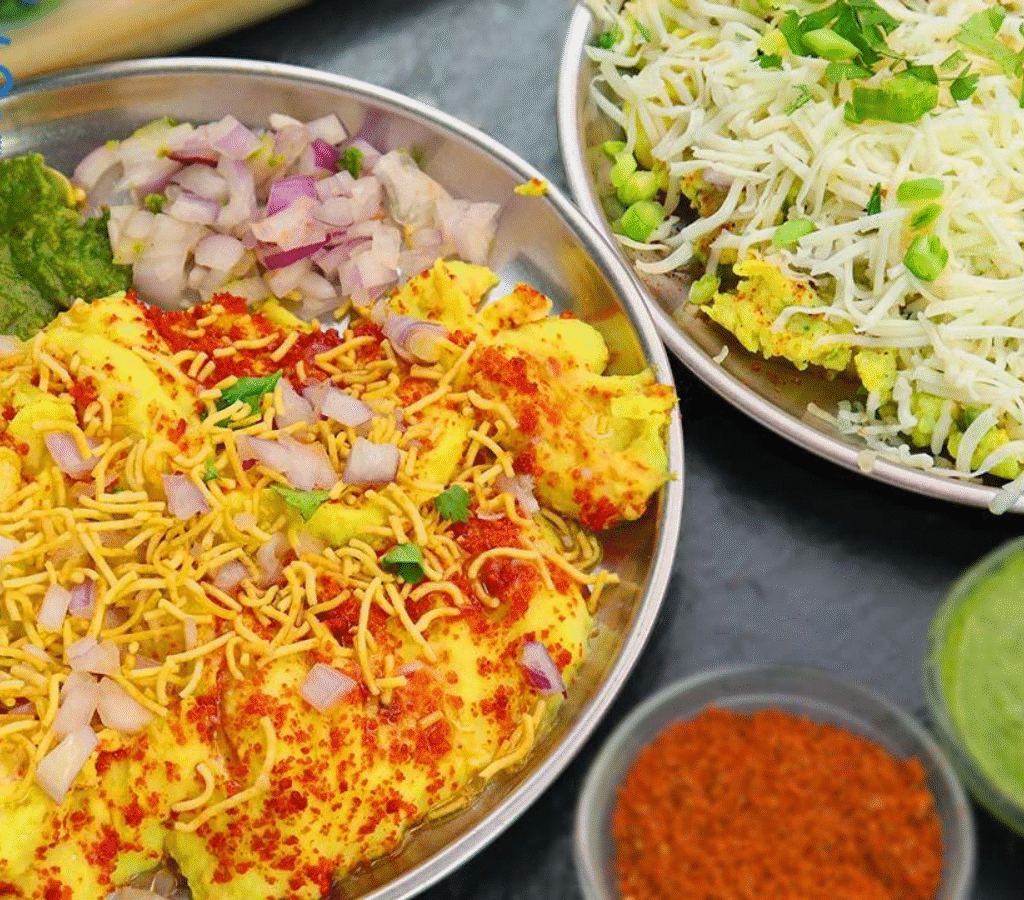1. Introduction: What is Locho?
Locho, also known as Surti Locho, is a beloved steamed farsan (savory snack) hailing from Surat in Gujarat, India. The name “Locho” stems from the Gujarati phrase for “something’s not right” or “a mess,” referring to the dish’s loose, irregular form—akin to a happy accident that turned into a culinary icon .
Unlike the neatly cubed khaman, Locho is intentionally soft, moist, and served as a gooey scoop topped with butters, chutneys, sev, and masala. Its unstructured form only adds to its charm and is what makes it so delightfully indulgent.
2. Historical Origin and Cultural Charm
Legend has it that Locho was born from a mishap while preparing Khaman. A chef added too much water to the batter, causing it to turn too runny to set into firm pieces. Dismissively calling it “locho,” he served it with toppings—and the too-soft Khaman turned out to be a crowd-pleaser .
Over time, this “mistake” became a household favorite. Today, it’s not just a dish but a nostalgic memory for Gujaratis who grew up enjoying it as a snack, breakfast, or a light dinner. The fun name and forgiving texture give Locho a lovable identity that resonates with many.
3. Ingredients: What You’ll Need
A. For the Batter:
- Chana Dal (Bengal gram) – 1 cup
- Urad Dal (split black gram) – around ⅓ to ½ cup
- Poha (flattened rice) – a few tablespoons; adds moisture and softness
- Optional: plain yogurt or a pinch of asafoetida (hing) to aid fermentation.
B. Seasonings for Batter:
- Ginger-chili paste
- Turmeric
- Salt
- A dash of oil
- Fermentation aids: Baking soda or Eno, OR you can ferment overnight for natural rising and flavor.
C. For Toppings:

- Locho Masala: a blend of chili powder, black salt, roasted cumin, black pepper—and optionally chaat masala .
- Sev, finely textured
- Finely chopped onions, coriander leaves, green chutney, butter or oil—classic accompaniments .
4. Step‑by‑Step Method
A. Soaking & Grinding
- Wash and soak chana dal and urad dal together in water for 6–8 hours or overnight.
- Soak poha for 10 minutes before grinding if using.
- Drain well and transfer to a blender; add just enough water (around 1¼ cups) to form a slightly coarse but smooth batter.
- Let the batter ferment in a covered bowl at room temperature for 6–8 hours—this yields a tangy and airy texture. If time is short, skip the fermentation; simply add baking soda or Eno just before steaming .
B. Seasoning & Adjusting
- Post-fermentation, mix in ginger-chili paste, salt, turmeric, and oils. Slowly add water to reach a pourable, medium-thick consistency—not too dense or runny .
C. Steaming

- Grease a steaming plate or pan with oil.
- Steam the batter on medium heat until it’s completely set—usually about 15–20 minutes depending on thickness. When done, the Locho will be springy and soft with a slightly wobbly texture.
- Allow a brief rest—then loosen edges and plate the Locho, keeping its loose structure intact.
D. Finishing & Toppings
- Top generously with butter or light oil.
- Mix and sprinkle locho masala evenly.
- Add finely chopped onions and sev for crunch.
- Drizzle green chutney or optional tamarind chutney for contrast. Garnish with coriander leaves and a squeeze of lemon for brightness.
- Serve immediately—the textural duo of soft Locho and crispy toppings is best enjoyed hot.
5. Tips, Variations & Troubleshooting
Tips for Perfect Locho
- Fermentation matters: It adds tang, lightness, and depth of flavor. If using baking soda or Eno, add it right before steaming for that bubbly life.
- Consistency is key: Batter should flow gently but not be watery—this ensures even steaming and the iconic soft texture.
Variations to Explore
- Regional tweaks include lasaniyo (garlic) Locho, cheese Locho, Schezwan Locho, butter Locho, even pizza-style Locho—creative spins on the classic .
- For a healthier variation, use yogurt and reduce oil, or use instant pot steaming for ease and convenience .
Common Obstacles
- Dense or unfermented texture: Could be due to too little fermentation, thick batter, or not enough leavening.
- Too wobbly or soggy: Might result from overly wet batter or inadequate steaming—adjust water and check the steamer temp.
6. Serving Suggestions & Pairings
Locho is perfect as a morning breakfast, afternoon snack, or a light dinner. Its protein-rich composition (from dals) makes it quite filling yet delightfully light—with under 100 kcal per 100 g.
Serve with:
- Traditional Gujarati farsan, or sesame sev and chutneys.
- Make it a mini-meal: pair with coral peanuts, curried potatoes, or a herbed yogurt side for balance.
- For casual gatherings, present it in small portions—each guest can top their own Locho with chutneys, onions, and masalas.
7. Conclusion
Read also: How to make khaman dokhla?

Locho stands as a testament to the beauty of simplicity and serendipity in cooking. Born from a mishap, it has become a cherished Gujarati staple—soft, flavorful, and wonderfully unconventional. With lentil-based batter, light steaming, and crunchy toppings, it’s a snack that’s easy to make but rich in character.
Whether you stick to the classic or experiment with cheese, garlic, or Schezwan spices, one bite of Locho promises a satisfying medley of textures and tastes. So, embrace the “messy,” authentic spirit of Locho—serve it hot, serve it well, and above all, enjoy every messy, melt‑in‑the‑mouth morsel!
